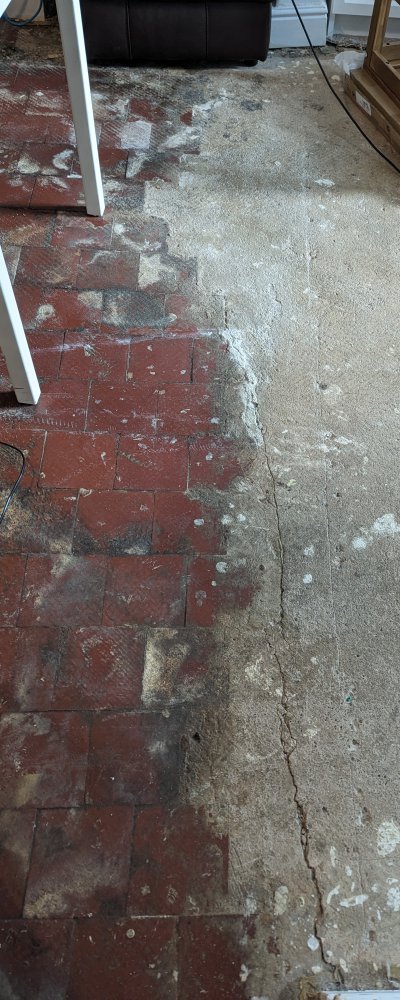connoros
Member
- Messages
- 2
- Location
- Nantwich, Cheshire
Hi
TLDR; pretty sure someone has put concrete over half my living/dining room and it's causing mild damp issues. How can we deal with the floor to be sympathetic to the history of the house, avoid damp but not spend a fortune?
First time house owner with a Victorian or Edwardian terrace in Cheshire, somewhere between 1898-1910 is all I've found out so far.
We have very little history on previous renovations, a lot of it was done before the previous owner, but there are many botched renovations and on-the-cheap DIYs around the house, with a lot of the original features long gone.
The downstairs has been opened up at some point to give an open plan living/dining area with a kitchen extension off the back. It's carpeted, and underneath we have quarry tiles in the living room but some kind of concrete in the dining room, with a completely haphazard borderline between the concrete and quarry tile.
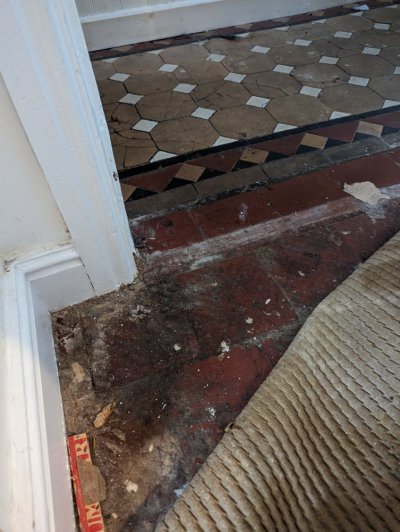
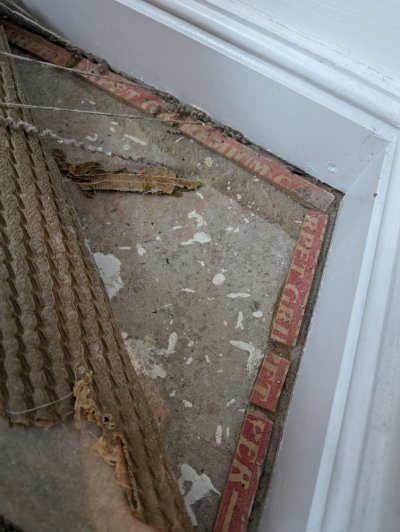
(The hallway tile is it's own project as well, sooo many cracked tiles and absolutely filthy after god knows how many cleans, but for another day)
To add to this, the dining room floor is significantly higher, maybe 2-3cm, than the quarry tile living room. This leads me to believe that the concrete has just been put over the quarry tile, but I haven't tested this theory yet.
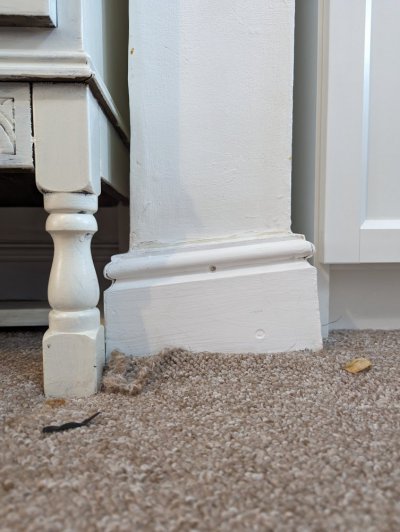 (yes, this picture is straight!)
(yes, this picture is straight!)
The concrete goes back to quarry tile when you reach the kitchen:
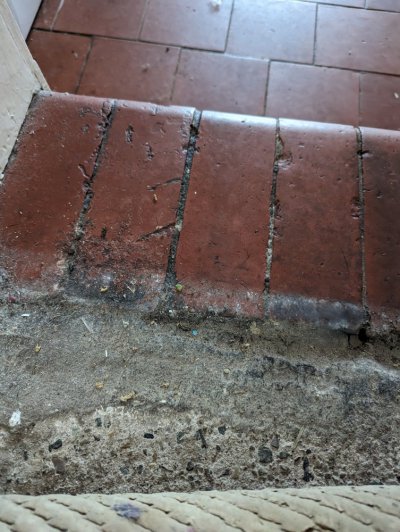
The quarry tile in the living room is pretty cracked, very dirty and covered in paint splatters, but potentially salvagable if I really wanted to.
Currently we've seen zero signs of damp in the living room, even in the bay window. There are visible air bricks around the bay window but they look blocked up. We haven't spotted any major damp issues in the dining room, but we had some problems with paint peeling/bubbling off the walls in the dining room after we first painted. We believe this was because someone painted straight onto fresh plaster before us, but can't be sure. The house was empty for 6 months before we bought it so I'd expect to have seen damp if we were going to get any.
So, what options do we have for the living room/dining room flooring?
We are very much DIY beginners and learning as we go, and we have limited funds that we'd love to save for redoing the very DIY bathroom.
Current thinking is:
TLDR; pretty sure someone has put concrete over half my living/dining room and it's causing mild damp issues. How can we deal with the floor to be sympathetic to the history of the house, avoid damp but not spend a fortune?
First time house owner with a Victorian or Edwardian terrace in Cheshire, somewhere between 1898-1910 is all I've found out so far.
We have very little history on previous renovations, a lot of it was done before the previous owner, but there are many botched renovations and on-the-cheap DIYs around the house, with a lot of the original features long gone.
The downstairs has been opened up at some point to give an open plan living/dining area with a kitchen extension off the back. It's carpeted, and underneath we have quarry tiles in the living room but some kind of concrete in the dining room, with a completely haphazard borderline between the concrete and quarry tile.


(The hallway tile is it's own project as well, sooo many cracked tiles and absolutely filthy after god knows how many cleans, but for another day)
To add to this, the dining room floor is significantly higher, maybe 2-3cm, than the quarry tile living room. This leads me to believe that the concrete has just been put over the quarry tile, but I haven't tested this theory yet.
 (yes, this picture is straight!)
(yes, this picture is straight!)The concrete goes back to quarry tile when you reach the kitchen:

The quarry tile in the living room is pretty cracked, very dirty and covered in paint splatters, but potentially salvagable if I really wanted to.
Currently we've seen zero signs of damp in the living room, even in the bay window. There are visible air bricks around the bay window but they look blocked up. We haven't spotted any major damp issues in the dining room, but we had some problems with paint peeling/bubbling off the walls in the dining room after we first painted. We believe this was because someone painted straight onto fresh plaster before us, but can't be sure. The house was empty for 6 months before we bought it so I'd expect to have seen damp if we were going to get any.
So, what options do we have for the living room/dining room flooring?
We are very much DIY beginners and learning as we go, and we have limited funds that we'd love to save for redoing the very DIY bathroom.
Current thinking is:
- Cheap laminate for now.
- Yes I know everyone hates laminate but we're skint millenials and spent all our money on avocados and a house deposit.
- Before I'd researched about quarry tile/letting old houses breathe, we really wanted wood flooring and we thought we could whack down some laminate as a temp measure for a couple of years. So I have a stack of laminate in the loft already.
- Plan was to screed, as half the old quarry tile is already ruined, and at least we'd still have the original hallway and kitchen tile, I don't really need a whole house of it. However, now I'm thinking this might create damp issues?
- We also thought about using different thicknesses of underlay to deal with the unlevel floor, or even a double layer in the lower living room section, this seems like it would still "breathe" a little bit round the edges - we'd use a scotia to finish the edge. Is this wishful thinking and recipe for disaster?
- My guess is that everyone is going to say absolutely hell no, but thought I'd check before I have to try and shift all this damn laminate!
- Screed over the remaining quarry tile
- I dislike this option for many reasons - might give us damp issues, ruins the quarry tile further, not sure how I'd make it work with hallway floor. But at least it's a level floor.
- Dig up the concrete and hope there's quarry tile underneath. Clean them up and get some rugs to keep our feet warm and hide the worst of the damage.
- Dig up the concrete and the quarry tile and get modern DPM and screed.
- Would this still cause potential rising damp through the walls?
- Presumably a big job and a lot of money
- Put new carpet over it and attempt to forget all about it for a few years.
- Everyone recommends limecrete but this looks to be way out of our budget for now.

